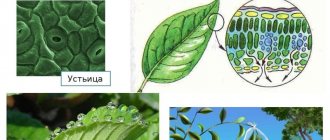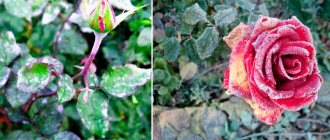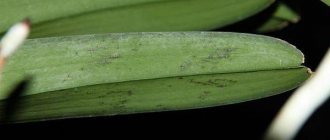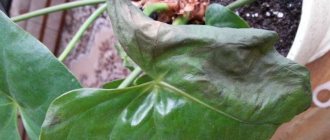What is it, what do they look like?
Spots on orchids are a sign of damage to the flower , which can be of viral or bacterial origin. They may differ in color, shape and degree of distribution.
Photos of affected plants
Here is a photo of orchids with spots on leaves and flowers:
Treatment and prevention of diseases
As can be seen from the table of symptoms, phalaenopsis is susceptible to many types of rot, which affect all parts of the plant. This variety of diseases associated with rotting is due to the moisture-loving nature of the flower, the specificity of substrate moisture and instability to long-term temperature changes.
The appearance of viral and fungal diseases in most cases is associated with poor-quality, contaminated substrate. Less commonly, viral diseases are transferred to the plant from other indoor flowers.
What to do when a plant starts to rot
Treatment of diseases such as brown and black rot in advanced stages (more than 30% of the plant is affected) is almost impossible. If a smaller area is affected by rotting, you can try to save the flower. To do this you need to perform some kind of operation. Carefully cut out the affected areas with a sterile knife, trying to minimize damage to healthy tissue. After the operation, sprinkle the cut areas with coal dust and treat with Bordeaux mixture. The substrate should be thrown away, the pots should be sterilized, and clean, healthy substrate should be poured into them.
Definition
- Belykh.
White spotting on leaves - what does it mean and for what reasons does it occur:- Chlorosis. This is not so much a disease, but only a symptom of previous diseases. It is distinguished by vague white spots on the leaf plate.
Powdery mildew. This is a fungal disease that causes purple-white spots on the leaf. Externally, the flowers look as if they were sprinkled with flour. This disease, if not treated promptly, can lead to the death of the plant. Read about white plaque on an orchid and how to combat it here.
- Chernykh .
If black round and small spots with a concave surface appear on the leaves of the orchid, then this is a sign of anthracnose. After a while, a pink or yellow coating appears. Late blight remains the next cause of black spot development. Over time, black spots spread over the entire surface of the leaf. Pathogen spores can remain in the soil for a long time. Read more about blackening of orchid leaves, flowers and roots here. - Brown.
Spots with a brown tint occur with the following pathologies:- Rust. This is a rare disease that affects orchids. It is a fungal infection that infects the leaf blade. Mostly weak orchid bushes are affected by the disease. It appears in the form of spots from the inside of the leaf blade, which acquire a reddish-brownish tint. This causes sporulation of fungi.
Rot. This is a common disease of orchids. Appears on the leaf plate in the form of brown spots with a fluffy formation.
- Hives. This disease is easily recognized by the presence of small brown spots, 3 mm in diameter. Over time, pigmentation spreads over the entire surface of the leaf.
- Wet.
Wet spots on orchid leaves occur as a result of the activities of the following pests:- Bristle bug. This parasite has a distinct reddish body color and an oval shape.
Citrus mealybug. This pest can take on different body colors: from orange to black.
When a flower is damaged by these pests, wet spots of white, pink and beige colors form on the leaf plate.
We invite you to watch a video about white spots on orchids:
Read about diseases of orchid leaves here.
Actions for various diseases - step by step
We will tell you how to help phalaenopsis in identifying common ailments.
Bacillus Cypripedium (Bacilus Cypripedium)
Simply put, the pathology is called bacterial rot. It must be combated as quickly as possible, since the disease spreads extremely quickly and ends with the death of the specimen.
Its main symptom is brownish spots that form first on the edges of the leaves, and then spread over the entire area of the plates and the stem. As a result, phalaenopsis becomes lethargic, and its green mass emits a characteristic putrid odor.
Be sure to wipe the place where the orchid previously stood with an antiseptic (the best option is chlorhexidine, but it is also acceptable to use hydrogen peroxide or regular “Whiteness”).
Each damaged leaf is removed with a sterile instrument. Moreover, it is necessary to cut, retreating at least a little to a healthy area. The wounds are treated with iodine. Weaker disinfectants, such as crushed charcoal, will not help.
Wait for the wounds to dry, and then wipe the entire flower with Bordeaux mixture. Do this only once, but very carefully. The copper contained in the product interferes with gas exchange, so risks must be minimized. Next, spray the culture with Phytobacteriomycin.
When Bacillus Cypripedium develops at the base of the stem, the phalaenopsis should be removed from the substrate, processed as described above, and kept for 14 days with bare roots.
Place the flower in a room where:
- very light;
- humidity within 55%;
- temperature about +22 °C.
It is necessary to water daily, immersing the orchid literally for a minute in a vessel with boiled water. Next, dry it thoroughly.
Replanting into the substrate is carried out after 2-2.5 weeks - provided that all signs of rot have disappeared.
Advice: it is better to throw away the old pot completely, since it is almost impossible to properly sterilize it.
Hives
This disease manifests itself as very small dots, rarely reaching a diameter of 3 mm. They are brownish in color. The disease affects exclusively foliage.
Getting rid of hives is easy. First of all, air humidity should be increased to 65-70%.
The temperature also rises. In summer, it is necessary to maintain +22 °C…+26 °C. In winter, +18 °C…+23 °C is enough.
Black spots on the leaves of the phalaenopsis orchid - late blight
This disease is indicated by the appearance of black rotting lesions at the base of the leaves. The stain grows gradually, covering the entire area of the plates.
The fungus produces viable spores that are able to retain the ability to develop for a long time once they get into the ground. In the early stages, phalaenopsis can still be saved.
To do this you need:
- cut off all infected areas with a sterile knife, with a margin of 1.5-3 cm;
- treat the wounds with brilliant green or iodine, and the plant as a whole with a strong fungicide;
- replace the substrate and pot.
In case of late blight, you must act as quickly as possible, since the flower can die in just 1-3 days. Be sure to disinfect the place where the diseased crop previously stood.
Dry dark and light spots
There is no need to treat such lesions unless they were wet or sticky to begin with.
The fact is that the lesions are formed not due to infection by microorganisms, but as a result of sun or any other thermal burn. This will be indicated by their predominant accumulation on the side facing the window (battery).
Typically, such stains do not spread and therefore do not pose a danger. In case of significant damage, it is worth removing the affected leaf, since it greatly spoils the appearance of the orchid and ceases to participate in photosynthesis.
If the spots are wet at first, then we are talking about fungal infections. In this case:
- cut out the sore spots with a knife wiped with alcohol;
- anoint with brilliant green;
- let the wounds dry;
- spray with fungicide.
Until recovery, reduce watering and provide intensive ventilation of the room.
Important: if the nature of the disease is unclear, then treat it alternately with several agents (antibacterial, fungicides) with an interval of 2-3 days.
Yellow spots - Mesophyll collapse (Mesophyll collapse)
This disease is signaled by the formation of yellowish spots. They spread unevenly and often over all leaves at once. The damage seems to be pressed into the thickness of the plates.
The main reason for the occurrence of pathology is the use of too cold water for irrigation (or spraying). The disease in question is of a physiological nature, that is, the plant reacts in a similar way to improper watering.
Use water at a temperature of +35 °C...+40 °C, and new lesions will not appear. Carefully remove unsightly leaves.
What are the reasons for the appearance?
Why do black, brown, white or dark spots appear on leaves and flowers? The following reasons can affect the development of spotting:
Exposure to direct sunlight . It is necessary to choose a flower habitat with diffused direct light.- Excessive watering . If you actively moisten the orchid, this will lead to rotting of the root system, so you need to carefully ensure that the soil has time to dry out before the next watering. Read about how to save an orchid damaged by the flood here, and find out how to carry out resuscitation if the orchid was left without roots in this material.
- Poor ventilation in the pot . Be sure to place a drainage layer in the container. Its height should be at least 1.5-2 cm. You also need to check whether there are holes in the container. They must be large so that the air can circulate fully.
- Lack of room ventilation . The air in the room should not stagnate, but drafts for the plant are also unacceptable. Everything should be in moderation.
- Incorrectly selected flowerpot . The development of the root system depends on the size and material of the pot. The container should not be small, but not too loose. Its size should be 2-3 cm greater than the volume of the rhizome.
- Disturbed irrigation regime . Orchids are classified into 2 types: those that need to be watered from above and those that are moistened by immersion. First, you need to determine the type of flower, as this will prevent water from stagnating in the tray of the pot.
- Bad substrate . You need to choose only the soil that is intended for the orchid; the rest are not suitable. It is important to ensure that the soil mixture is homogeneous and does not form lumps after moistening. The soil should also contain coniferous bark.
- Incorrect application of fertilizers . When choosing fertilizers, be sure to ensure that they are intended exclusively for these plants. You can study the information on the packaging of the mineral complex. And when adding the nutritional composition, you should not overdo it with the dosage.
Read about what to do if your orchid has spots on its leaves, flowers, or roots.
Non-infectious diseases of orchids
Non-infectious injuries result from heat exposure or sunburn. The plant can be damaged both by the rays of the sun and by cold air. Proper care at home is required.
Leaf deformation
Fractures occur as a result of mechanical action. But there is another deformation of the leaf plate caused by a lack of moisture or severe hypothermia. Some parts of the leaf become irregular in shape and look crushed. The reason may be overfeeding with nitrogen, breaks, cracks, and discoloration appear.
It is necessary to reconsider the temperature regime, increase watering, and abandon nitrogen fertilizers. Take the plant out of the pot, wash the roots, then transplant the flower into another substrate.
Interesting!
After transplantation, the orchid stops growing for a while and flowers do not appear, but this is a temporary phenomenon until adaptation occurs.
Leaf burn
Burns can be thermal or solar. Colorless lesions with a brown border appear in spring or summer with active sun. They provoke a burn by evaporation on the foliage in the form of water droplets. Thermal damage occurs from low-mounted lamps during backlighting. Dry streaks or spots appear on the foliage.
Light-loving species, starting in spring, need to be gradually accustomed to sunlight. Burns can also occur from batteries when the leaves hang low over the radiator. A burn is a thermal effect and is not a disease. It is better to remove damaged leaves. Place the flower in places with diffused lighting or shade a window.
Frostbite
Frostbite occurs in late autumn or winter when phalaenopsis stands near an open window or comes into contact with window glass. First, wrinkles appear on the leaves, tubercles that turn into spots.
Damaged leaves cannot be restored; they are cut off. The bush is moved to a warm place without drafts. Leave the flower alone for about 8-10 days without watering or fertilizing. If the growing point is frostbitten, it is removed. Such an orchid will reproduce only from the root child.
How to deal with spotting: step-by-step instructions
On the leaves
Depending on the disease that led to the development of orchid spotting in the area of the leaf blade, there is a specific treatment method:
- Urticaria . To combat this disease, it is necessary to increase the air temperature in the room and lower the humidity level to 50-70%.
Late blight . It is no longer possible to save a plant that has been affected by late blight, so you will have to say goodbye to it. But there are several rules that will help avoid the development of a pathological process:- do not increase air humidity;
- make sure the room is warm;
- Do not leave drops of water on parts of the flower.
- Powdery mildew . To treat an orchid, you need to spray it with Skor or a solution of colloidal sulfur. Only at the beginning of therapy, water the flower thoroughly, and after 2 hours proceed to treatment.
- Rust. The method of treating this disease is similar to those given above. Immediately remove the affected areas and treat the cut with a 25% alcohol solution. To treat the flower, the following spraying preparations are used:
- Mikasan;
- Speed;
- Ritomil.
- Rot . If the plant has been affected by rot, you will have to spray it with a fungicide. In case of secondary damage, it is worth using another drug, since rot spores quickly adapt to the means used.
On flowers
Spots on the leaves of the bud are the first signal that the orchid has been affected by a fungal or bacterial disease. It all starts with yellowing of the foliage, which over time darkens and becomes elastic. Then the petals become covered with moist ulcers, from which a liquid substance flows.
To save flowers from this infection, it is necessary to cut off the affected petals and treat the cut areas with iodine. More potent drugs can be used. But do this if the pathology is neglected.
Reference! If 2 weeks after treatment no new spots appear on the buds, then the plant is no longer infectious and can be removed from quarantine.
Fungal infections
These are the most common and numerous forms of the disease, which often result in the death of orchids. The growth of fungi is provoked by severe waterlogging, overheating, and lack of ventilation. In such conditions they progress very quickly.
Black rot
The causative agent of the infection is fungi of the species Pythium ultimum and Phytophthora cactorum, which infect the root system, which first leads to inhibition of plant growth and then death.
Mold in a flower pot
The disease affects a wide range of orchid species, but cattleyas are considered the most susceptible. Fungal spores are easily transmitted from plant to plant, spread through watering, splashes, and tools. The development of this orchid disease is promoted by too wet growing conditions, for example, a constantly wet substrate.
Infected tissues of pseudobulbs and Cattleya leaves
Ground symptoms. Weeping spots along the edges of the leaves, softening of young shoots, black or brown longitudinal stripes of affected tissue on the leaves, black-brown coloring of the root collar, rotting spots on the bulbs and roots.
Treatment. The plant is removed from the soil, the infected parts are removed with a sterile instrument, then the roots are kept in the fungicide for 15-20 minutes. Replant into new soil and pot. Of the drugs, the most effective are metalaxyl and mefenoxam at a dosage of 1 g/l of water.
Black rot
After treatment, follow the watering regime and observe the plants for 1-2 weeks, then treat the above-ground part, preferably in the morning. There is no watering on the day of treatment.
Fusarium wilt
A special group of fungal diseases of orchids is tracheomycosis or fusarium wilt, which is distinguished by the fact that it does not affect the external parts of orchids, but penetrates their vascular system and clogs it, while simultaneously poisoning the plant with its toxic waste products.
Homemade fertilizers for indoor flowers
Tracheomycosis is dangerous because at the initial stage the disease is quite difficult to identify. And the already advanced stage is very difficult to treat.
Causes. Excessive humidity, waterlogging and/or low temperatures. The pathogen often spreads as a result of the use of unsterile cutting instruments; salinity of the substrate can trigger the disease in phalaenopsis.
Fusarium wilt of phalaenopsis
Symptoms. It begins with yellowing, wrinkling or wilting of the lower leaves, and the wilting may be unusual and one-sided. In parallel with wilting, rotting of the roots, lower part of the stem, and neck occurs. The growth of roots is disrupted - they either do not grow at all or grow very poorly.
The infection also results in chlorotic spots on the leaves. The affected tissue enlarges and develops necrotic brown and then blackish-brown spots and stripes, and younger leaves become reddish. Dark spots often appear on the flower stem, and flowers fall off prematurely.
All these symptoms can appear simultaneously or separately.
The diagnostic symptom of Cattleya is a circle or stripe of purple or pinkish-purple color on a cut of the rhizome. If the disease is extensive, the rhizome may turn purple and the discoloration may extend to the pseudobulbs. Heavily infested plants may die within 3-9 weeks, while moderately infested plants die within a year.
A purple-red stripe on the root of Cattleya is a symptom of advanced fusarium
Treatment. Immediately remove all affected parts of the plant, disinfect the cuts with charcoal powder. Treat the entire plant with a fungicide and replant it in new soil.
For cattleyas, remove the infected part of the rhizome and pseudobulb if a purple streak is noticeable. Replant only the part of the plant that does not have purple color on the rhizome cut.
The disease is difficult to treat; heavily infected orchids are best destroyed.
Sclerotial root collar rot
Another disease of orchids at home. The main symptom is rapid rotting of the roots, root collars and lower parts of the leaves, which first become light yellow and then, as the infection progresses, dark brown, the tissue very quickly breaks down and rots.
Phalaenopsis orchid disease
Small yellow or yellow-brown sclerotia are formed on the leaves - fungal mycelia that resemble mustard seeds. This is the resting form of the mushroom. Sometimes you can find the growth of porcini mushrooms on the stems, pseudobulbs and leaves.
The disease eventually affects and destroys the entire lower part of the orchid. The pathogen spreads at high temperatures and humidity.
Mistakes in caring for orchids and their consequences
Treatment is to remove the infected part of the roots and leaves with a sterile instrument, treat the entire plant with a fungicide, and disinfect the pot with a 10% bleach solution.
Prevention consists of proper care, good air circulation, and maintaining temperature conditions.
Brown root rot - rhizoctonia
The cause of the disease is the following factors:
- poor soil quality and/or salinization due to irrigation with hard water;
- constantly wet substrate.
The symptoms of rhizoctoniosis are similar in appearance to fusarium. The disease most often manifests itself as root rot, which can spread further to the neck, bulb, rhizome and stems. Moreover, only the roots get wet and decompose. Other parts affected by rot simply dry out.
Phalaenopsis root rot
The leaves turn yellow or brown, wrinkle, may crack, and finally fall off. Old pseudobulbs in orchids with a sympodial growth pattern gradually become brown from bottom to top. In phalaenopsis, the tips of the aerial roots and the root collar begin to darken.
Treatment of phalaenopsis and other orchids is similar to Fusarium wilt and is more successful. With timely replanting, removal of the affected parts of the plant and repeated treatment with a fungicide, the orchids recover. Water carefully, 10-12 days after transplantation.
Cattleya rhizoctonia
Prevention. If you suspect a disease, remove the flower from the pot and examine the roots. Replant if necessary. In homes with hard water, pots should be rinsed at least once a month to prevent salt buildup.
Anthracnose
Symptoms. This fungal disease affects the aboveground part of the plant. First, the tips of the leaves turn brown, then brown-black with a yellow halo, then the entire leaf darkens. Dark brown or light gray spots sometimes appear in the form of concentric rings or in the form of numerous stripes on the leaf.
Cymbidium anthracnose
The affected area is usually well-defined and somewhat depressed, while the rest of the leaf appears normal. Flowers become covered with watery black or brown pustules. The spots can merge and cover the entire flower.
The causative agents are the fungi Colletotrichum gloeosporioides and Colletotrichum theobromicola. The second fungus additionally causes chlorotic spotting on the upper surface of the leaf and black spotting on the underside of the leaf.
Phalaenopsis anthracnose
The pathogen is most active in warm weather, when there is little light and a lot of moisture.
Treatment of the above-ground part is carried out with fungicides containing copper. Such a plant does not need to be replanted, but it is also necessary to treat the top layer of soil, which could get infected with fungal spores.
Proper care, good air circulation, cool temperatures (if possible) and adequate lighting help reduce the spread of this disease.
Cercospora
Fungal spot caused by fungi of the genus Cercospora. In the early stages of infection, the infection appears as yellow spots. As the spots progress, they become larger, slightly sunken, and purple-brown to purplish-black.
Cercospora blight of phalaenopsis orchids
The spots continue to grow in a circular or irregular pattern and may eventually cover the entire leaf. Heavily infected leaves usually drop prematurely, especially if the infection begins near the base of the leaf.
Pseudocercospora
One of the spots, which is also caused by fungi of the genus Cercospora. Depending on the type of pathogen and the variety of orchid, the shape of the spots may be different, but more often it is round, reflecting the growth pattern of the fungal colony. The color ranges from purple to gray-black with many brown or black spots.
Pseudocercospora
Other species of cercospora fungus produce smaller, irregular spots, usually in larger numbers, creating a mosaic pattern on the upper surface of the leaf blade. The underside may be covered with dots, spore bodies that often correspond to patterns on the upper surface of the leaf.
Phyllosticosis
A disease of this genus of orchids can begin on any above-ground part of the plant. Most often found on dendrobiums and Vande orchids. The spores are easily spread by splashing water and grow quickly in humid and warm conditions.
Phyllosticosis
The first signs of infection in Vandas appear as elongated, tiny purple or black spots along the leaves.
These lesions gradually increase in size, appearing as long black streaks. Necrotic spots appear with a gray area of dead tissue. As the infection progresses, the spots may merge.
On dendrobiums, the disease appears as leaf spotting, starting with small round yellow spots. As they grow larger, the spots become more depressed, dark brown in color and have a red or purple-black halo, with raised spore structures developing in the center.
Although phyllosticosis does not kill the orchid, it can weaken the plant to the point that it easily succumbs to pests or other diseases.
Replanting phalaenopsis with step-by-step instructions
Treatment. Remove and dispose of infected parts of the plant to prevent fungal spores from getting into the soil, treat the entire flower with an antifungal drug.
Some gardeners cover the spots with clear nail polish in the early stages of the disease to prevent the spread of fungus. Unfortunately, the disease is incurable and you can only control its spread.
Septoria
Symptoms. Small longitudinal yellow spots on the leaf surface increase over time, darken and can merge, affecting the entire leaf. Treatment of infected orchids against the disease is carried out with fungicides containing copper.
Septoria
High humidity promotes the development of the disease.
Gray mold or botrytis gray
The causative agent of the disease is the fungus Botrytis cinerea. Characteristic symptoms of the disease: very small, black or light brown spots on flowers and buds. The spots can increase in size and cover the entire flower.
Treatment. Remove infected flowers, then spray with a suitable fungicide, such as daconil. Some gardeners report success with baking soda treatments. 1/2 teaspoon is dissolved in 1 liter of water and sprayed on the affected parts of the plant.
Phalaenopsis flowers affected by gray mold
The development of the pathogen is favored by conditions of high humidity with cold nights and poor air circulation.
Disease prevention
What to do if white, black or dark spots appear on the leaves and what treatment is required? It is almost impossible to cure pigmentation on orchids , so it is better to prevent its occurrence, I will use the following recommendations:
Maintain a comfortable air temperature around the flower. It should be 22-25 degrees during the daytime and 16-19 at night. It is important to provide the flower with a daily temperature difference of 4-5 degrees.- Provide good lighting for 10-12 hours a day. Just make sure there is no direct sunlight.
- For watering, it is better to use the immersion method. This method provides complete water supply for the plant, while preventing stagnation of liquid in the pan.
- It is not recommended to feed the orchid during flowering. This procedure will cause oversaturation of nutrients, as well as disturbances in the appearance of the flower.
- Choose only the soil mixture that will not clump into clumps after moistening and can allow water and air to pass through to ensure their circulation.
Frequent ventilation of the room will help prevent the development of spotting on orchids so that there is no increased temperature and humidity. It is not recommended to place orchids tightly next to each other, and also to ensure that water does not linger on the foliage for a long time. Water only in the morning, and install a fan in a room with a large number of plants.
How to save a culture if there are no roots left?
The sooner a problem with the phalaenopsis root system is noticed, the greater the chance of resuscitating the plant. Root extension can be done.
- Remove the flower from the soil and rinse under water.
- Leave for several hours to dry.
- Trim rotting roots back to living tissue.
- Treat the cut areas with cinnamon, ash or activated carbon.
- Let it dry and start growing roots.
To grow roots use:
- sphagnum moss;
- a mixture of moss, vermiculite and bark;
- water.
The procedure must be carried out in a small greenhouse or room.
You can make a greenhouse from an aquarium or a plastic bottle.
- Pour expanded clay into a pot with a diameter of 5-7 centimeters.
- Place moss on top.
- Place an orchid rosette on it so that it comes into contact with the moss in the place where the roots will begin to grow.
- Moisten the moss by spraying.
Wipe the leaves with a solution of succinic acid every day in the morning.
Problems during cultivation
Why do the leaves of the Phalaenopsis orchid turn yellow and what to do?
- if Phalaenopsis stands on a sunny windowsill, its leaves may get sunburned;
- if a flower stands in the back of the room, away from sunlight, its leaves will stretch out, become sluggish, and lose turgor. Therefore, it is important to guess where the flower is most comfortable and organize a place of residence for Phalaenopsis there.
- if you do not protect it from drafts when ventilating the room;
- if the pot is in the way of air flow from the air conditioner;
- if you keep it for a long time at low temperatures;
- if you over-moisten the substrate, the roots may not have enough oxygen and they begin to rot. Leaves turn yellow and fall off;
- sometimes, with frequent heavy watering, brown spots soaked in water appear on the leaves, stems or flowers. Over time, they increase in size and merge into large spots. During humid, warm weather, pink, gelatinous masses of spores appear in the centers of these lesions. These are characteristic signs of a disease called Anthracnose. Treatment begins with removing diseased areas from the plant, then treating the sections with crushed coal or iodine. For greater confidence, treat with the biological preparation Mikosan or a copper-based fungicide;
- with bacterial or fungal infections, spots of different colors appear on the leaves, sometimes becoming wet. Bacterial leaf spot is especially dangerous. It is necessary to prune all affected areas of the plant. Treat the sections with crushed activated carbon or iodine. If no new spots appear within 10 to 14 days, the treatment can be considered successful. If there is the slightest doubt, treat the orchid with Mikosan and the substrate with a 0.2% solution of Previkur.
This may be interesting: General rules for caring for Dendrobium orchids











